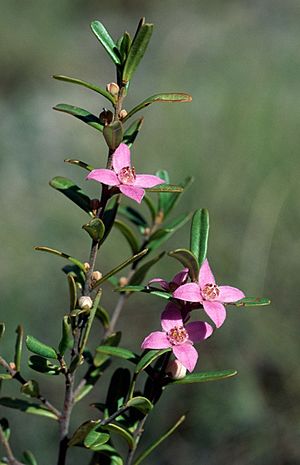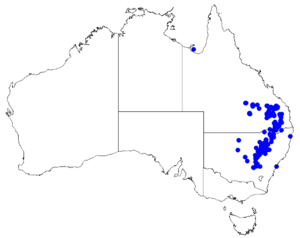Sandstone boronia facts for kids
Quick facts for kids Sandstone boronia |
|
|---|---|
 |
|
| Boronia glabra in the Carnarvon National Park | |
| Scientific classification | |
| Genus: |
Boronia
|
| Species: |
glabra
|
 |
|
| Occurrence data from Australasian Virtual Herbarium | |
Boronia glabra, also known as sandstone boronia, is a special plant found only in eastern Australia. It belongs to the citrus family called Rutaceae.
This plant is usually a shrub that stands up straight or sometimes has weaker, spreading branches. It has smooth leaves that are a bit lighter underneath. Its bright pink flowers have four petals and grow one by one where the leaves meet the stem.
Contents
What Does Sandstone Boronia Look Like?
Sandstone boronia is a shrub that can grow from about 0.4 to 1.5 meters (1 to 5 feet) tall. Its younger branches are covered with soft white hairs.
Leaves and Flowers
The leaves are shaped like an oval, about 5 to 35 millimeters (0.2 to 1.4 inches) long and 1.5 to 7 millimeters (0.06 to 0.3 inches) wide. The underside of the leaves is a bit paler.
The bright pink flowers grow on a small stalk called a pedicel, which is 1 to 6 millimeters (0.04 to 0.24 inches) long. Each flower has four small, egg-shaped or triangular sepals, which are like tiny leaves that protect the bud. These sepals are about 3 millimeters (0.12 inches) long.
The four main petals are 4 to 7 millimeters (0.16 to 0.28 inches) long. They get bigger as the fruit starts to grow. Inside the flower, there are eight stamens, which are the parts that make pollen. These stamens have tiny hairs that look like glands near their tips.
Flowering and Fruit
Sandstone boronia usually blooms from July to October. After the flowers, small fruits develop. These fruits are about 5 to 6 millimeters (0.2 to 0.24 inches) long and 2 to 3 millimeters (0.08 to 0.12 inches) wide.
How Sandstone Boronia Got Its Name
The sandstone boronia was first officially described in 1899 by two scientists, Joseph Maiden and Ernst Betche. They gave it the name Boronia ledifolia var. glabra. Their description was published in a science journal called Proceedings of the Linnean Society of New South Wales. They studied a plant they found near Peak Hill.
Later, in 1928, another scientist named Edwin Cheel decided that this plant was special enough to be its own species. So, he changed its name to Boronia glabra. The word glabra comes from Latin and means "hairless" or "smooth." This describes the plant's smooth leaves.
Where Does Sandstone Boronia Grow?
This type of boronia plant grows in open woodlands. You can find it in an area stretching from Eidsvold in Queensland all the way down to Cowra in New South Wales.
Is Sandstone Boronia Protected?
The Queensland Government has a law called the Nature Conservation Act 1992. Under this law, Boronia glabra is listed as "least concern." This means that currently, there are enough of these plants, and they are not considered to be in danger of disappearing.

